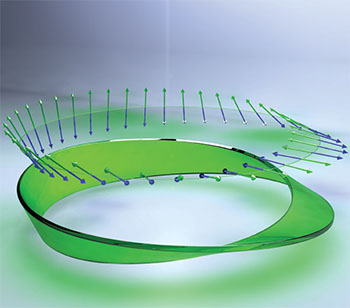
The scientists created tiny optical Möbius strips by altering the polarization in structured laser light. [Image: University of Rochester]
Many a budding young mathematician has gotten his or her first taste of non-Euclidean geometry by making a Möbius strip—a “one-sided” object created by twisting a strip of paper and fastening it into a loop. A team of researchers from Germany, Canada, the United States and Italy has now reportedly created optical analogs of Möbius strips by manipulating the polarization of laser light (Science, doi: 10.1126/science.1260635). The feat is more than just a parlor trick, however; the scientists suggest that the new technique could prove useful in fashioning exotic nanostructures in polymers and metamaterials that have previously been difficult or impossible to create.
The notion that structured light from a pair of laser beams might be made to oscillate in a Möbius-strip-like shape by manipulating their polarization has been around for about 10 years. But realizing that mathematical vision experimentally has proved very tricky. To do so, the international team behind the new study passed a circularly polarized green laser beam through a q-plate—a series of liquid crystals oriented at various angles to alter the beam’s intrinsic spin component and add optical angular momentum. The resulting structured beam exiting the q-plate was a superposition of two circularly polarized modes, one right-handed and one left-handed.
The team then focused the structured beam through a microscope lens and onto an 82-nm-diameter spherical gold nanoparticle. Another microscope and a camera system allowed the scientists to capture the scattered and transmitted light from the nanoparticle and to analyze it to reconstruct the electric field’s topology. What the team saw were Möbius strip distributions of polarized light measuring 200 to 250 nm in diameter. And they could adjust the number of “twists” in these diminutive strips by changes in the q-plate.
Apart from being an interesting advance in teasing exotic polarization topology out of light, the experiments could, in the view of the authors, point to some potentially new and useful forms of photolithography or other optical fabrication. These could be used, they say, in creating “material microstructures with nontrivial topology for new functional media, e.g., metamaterials with exotic optical properties or molecular-shape-selective membranes or substrates.”
